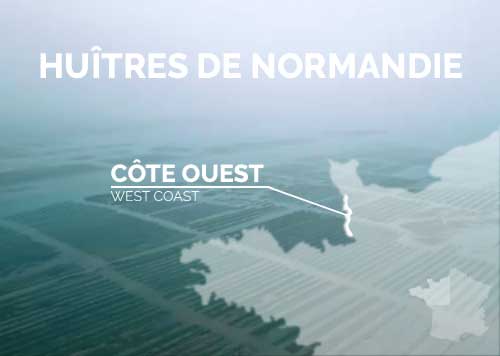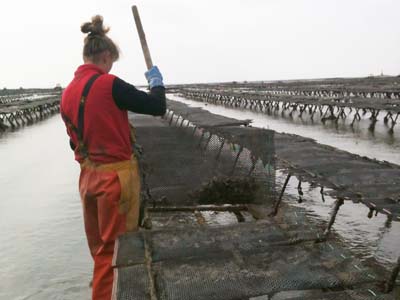
West Coast

West Coast

| Average | Basket weight | ||||||
| weight | and number of oysters | ||||||
| Calibers | 1 oyster | 6pcs | 12pcs | 24pcs | 36pcs | 48pcs | 96pcs |
| 1 | 135g | 0,82kg | 1,8kg | 4kg | 5kg | 8kg | 15kg |
| 2 | 102g | 0,6kg | 1,25kg | 2,5kg | 4kg | 5kg | 11kg |
| 3 | 75g | 0,45kg | 1kg | 2kg | 3kg | 4kg | 8kg |
| 4 | 55g | 0,36kg | 0,75kg | 1,5kg | 2kg | 3kg | 6kg |
| 6pcs | 12pcs | 24pcs | 36pcs | 48pcs | 96pcs | ||
| Number of oysters | |||
| per basket | |||
| 6kg | 8kg | 15kg | Calibers |
| 42 | 54 | 102 | 1 |
| 54 | 70 | 128 | 2 |
| 72 | 96 | 180 | 3 |
| 96 | 128 | 240 | 4 |
| 6kg | 8kg | 15kg | |
We also offer original packaging.

Each production area is like a terroir offering different and varied flavors.
On West Coast of Cotentin, the taste of oysters is wild and iodized.
Ratio of flesh to total weight: the higher is this ratio, the fleshier is the oyster.
Fine Oyster: the ratio of flesh is under 10.5%, the oyster is thinner in the mouth.
Special Oyster: the ratio of flesh is over 10.5%, the oyster is more voluminous in the mouth.

For its reproduction, the oyster abandons its eggs (spat) which bind on supports prepared by sea farmers.
The largest tides in Europe are on the coasts of Normandy and the streams are so strong that oysters can’t reproduce easily. The sea farmers of Normandy get their spats in the south of France. Oysters then grow for 18 months in the open sea, on the part of the foreshore which is discovered by the sea during the very high tides.

Once removed from their collectors, small oysters are placed in mesh pockets to allow seawater to flow. The pockets are attached on tables.
More than one billion litres of water charged with plankton through the gills of the oysters. The pockets are regularly turned (about 20 times) to prevent the oysters to stick and to give them a good shape.

Oysters are brought to foreshore where the sea uncovers at every low tide in order to “fool” them, that is to say that they are alternately subject to immersion at high tide and sun and wind at low tide.
Thus, they are forced to open and close frequently which strengthens their muscle that connects the two shells and make them stronger. The shell hardens and the flesh takes on its aroma. Then oysters are ready for shipping out of water.
During the production, the oysters need steady cares.
Pockets have to be cleaned to allow a smooth flow of water. They also have to be split so that the oysters are not too packed when growing.
Each pocket is moved, turned and split every 3 to 4 months at the beginning of the growth and then 3 to 4 more times before shipping.